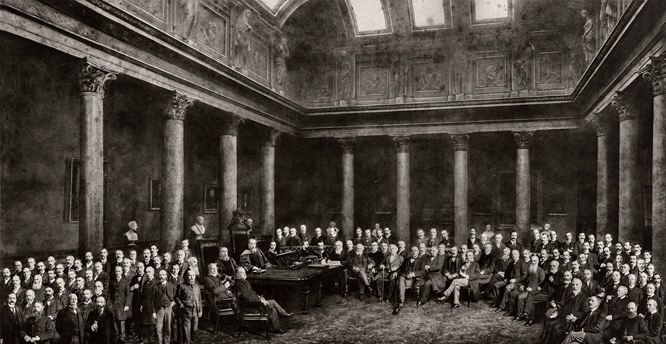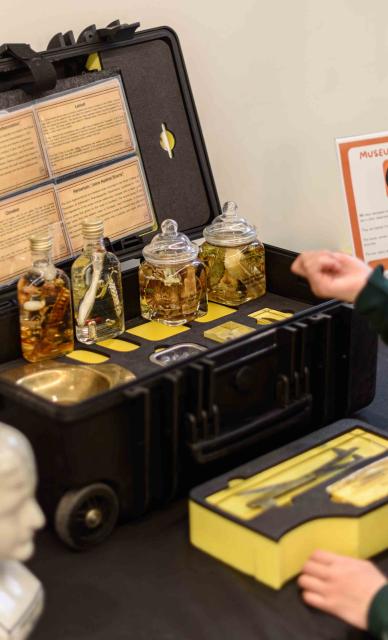Support us
As a charity we rely on your donations to fund our free exhibitions, school activities and online resources
Empowering medical excellence, shaping healthcare futures.
The College's collection provides a fascinating insight into both neoclassical sculpture and the history of the College itself. The portrait busts tell some of the College’s history as the majority of the subjects were once members of the College. Moreover, many of these figures played a significant role in the development of medicine and medical practice, both in Scotland and beyond. For instance, Sir James Young Simpson (President of the College 1850-1852) considerably advanced the field of obstetric practice.
Further to this, the 35 portrait busts in the collection provide valuable examples of nineteenth-century medical portraiture, particularly in the Scottish context. The majority of the busts are in a neoclassical style, with the sitters depicted in classical robes. In the remaining pieces, for instance the busts of James Warburton Begbie and Daniel Rutherford Haldane, the sitters are depicted in contemporary garments, sometimes their academic robes. However, despite the differences in their clothing, these pieces predominantly offer idealised portrayals of their subjects, a feature which is also seen in neoclassical sculpture.
This idealising tendency is also apparent in the statues and roundel portraits in the collection, for instance the two statues by Anthony Lazzaroni which are found in the vestibule. Furthermore, similarly to the portrait busts, the figures depicted by the roundel portraits have all been identified. However, whilst some have linked the statues by Lazzaroni and those in the Great Hall to classical and mythological figures, particularly Hygeia, no definite affirmation of this association can be made. Indeed, due to the lack of evidence amongst the College’s own records, in addition to an absence of symbolic features such as Hygeia’s snake in the statues, it appears that these pieces were selected primarily for their aesthetic impact, rather than any symbolic value which they may possess.
Interestingly, this also appears to have been the case in the selection of some of the busts. A receipt in the College’s archive records a payment made to George MacCallum for expenses incurred in travelling to London to procure the busts of ancient physicians, such as Hippocrates and Galen, for the College. This is perhaps somewhat unusual, as it would have been possible for the College to order busts from the catalogues of companies, such as D. Brucciani & Co., without having to send an envoy to London. It appears therefore that the College sent MacCallum, a sculptor, to choose pieces which would be particularly aesthetically effective, although it is not known whether MacCallum was given any particular instructions concerning the subjects of the busts which he selected beyond the fact that they had to be ‘ancient physicians’. It is probable that MacCallum purchased the busts from Brucciani & Co., or a similar company in London, and MacCallum’s aesthetic preferences may be the reason that the College possesses duplicates of certain busts (for example Hippocrates and William Harvey). MacCallum was also paid for the roundel portraits and classical female figures which appear in the Great Hall. However, despite the records of these payments, it is unclear whether MacCallum actually executed these pieces or whether he may have also outsourced their production to another sculptor, a cast-maker, or a company like Brucciani & Co.
Nevertheless, overall, the College’s sculpture collection provides a fascinating insight into both nineteenth-century medical portraiture and neoclassical aesthetic sensibilities. Furthermore, the significance of the collection is enhanced by its location in the College’s premises at no.9 Queen Street which are in a Late Greek Revival style, designed by Thomas Hamilton in the first half of the nineteenth century. Classicising features are found throughout the building, for instance the Corinthian columns which are seen in the Great Hall and on the main façade. Moreover, many of the aesthetic features are designed to emphasise the College’s identity, for example the College’s crest can be seen to be worked into the decorative balustrade on the main staircase. The statues of Hygeia , Hippocrates and Asklepios appear above the main portico, whilst gilded cockerels, symbolising Asklepios appear on the japanned caps of the exterior lights. The sculpture collection, alongside the College’s collection of oil paintings, plays a particularly significant role in visualising the College’s history.

The Royal College of Physicians of Edinburgh, 1902, by Barclay Bros., 143 Princes Street, Edinburgh.
This photograph was taken in the Great Hall and visible in the background are the statues and roundel portraits, as well as busts.
Blog Author: Mona O'Brien

Support us
As a charity we rely on your donations to fund our free exhibitions, school activities and online resources